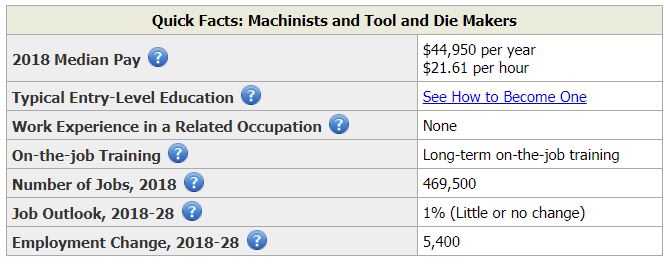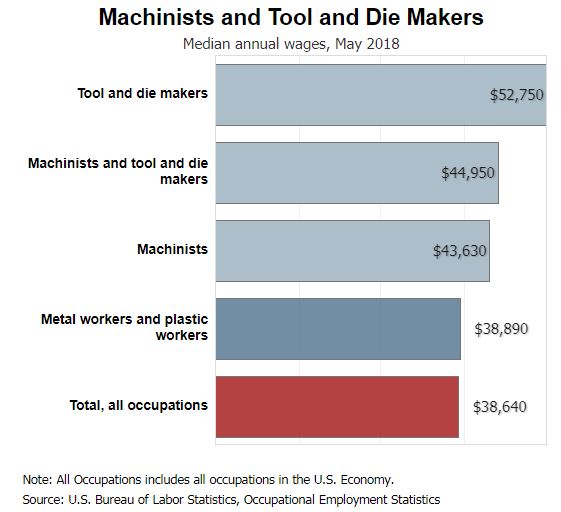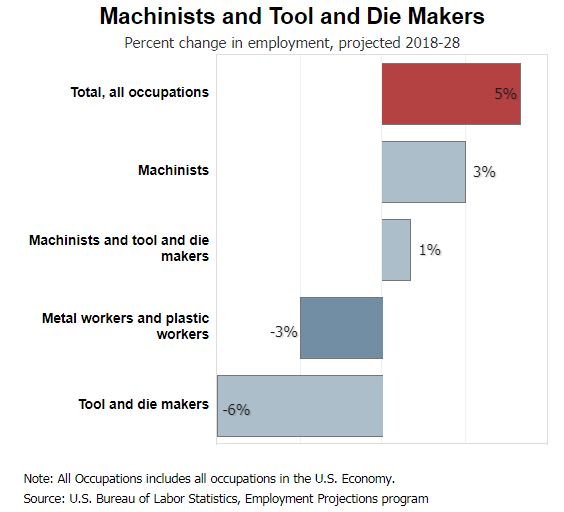Machinist
Machinists and tool and die makers set up and operate machine tools to produce precision metal parts, instruments, and tools.

Machinists and tool and die makers set up and operate a variety of computer-controlled and mechanically controlled machine tools to produce precision metal parts, instruments, and tools.
Duties
Machinists typically do the following:
- Read blueprints, sketches, or computer-aided design (CAD) and computer-aided manufacturing (CAM) files
- Set up, operate, and disassemble manual, automatic, and computer numerically controlled (CNC) machine tools
- Align, secure, and adjust cutting tools and workpieces
- Monitor the feed and speed of machines
- Turn, mill, drill, shape, and grind machine parts to specifications
- Measure, examine, and test completed products for defects
- Smooth the surfaces of parts or products
- Present finished workpieces to customers and make modifications if needed
Tool and die makers typically do the following:
- Read blueprints, sketches, specifications, or CAD and CAM files for making tools and dies
- Compute and verify dimensions, sizes, shapes, and tolerances of workpieces
- Set up, operate, and disassemble conventional, manual, and CNC machine tools
- File, grind, and adjust parts so that they fit together properly
- Test completed tools and dies to ensure that they meet specifications
- Smooth and polish the surfaces of tools and dies
Machinists use machine tools, such as lathes, milling machines, and grinders, to produce precision metal parts. Many machinists must be able to use both manual and CNC machinery. CNC machines control the cutting tool speed and do all necessary cuts to create a part. The machinist determines the cutting path, the speed of the cut, and the feed rate by programming instructions into the CNC machine.
Although workers may produce large quantities of one part, precision machinists often produce small batches or one-of-a-kind items. The parts that machinists make range from simple steel bolts to titanium bone screws for orthopedic implants. Hydraulic parts, antilock brakes, and automobile pistons are other widely known products that machinists make.
Some machinists repair or make new parts for existing machinery. After an industrial machinery mechanic discovers a broken part in a machine, a machinist remanufactures the part. The machinist refers to blueprints and performs the same machining operations that were used to create the original part in order to create the replacement.
Some manufacturing processes use lasers, water jets, and electrified wires to cut the work piece. As engineers design and build new types of machine tools, machinists must learn new machining properties and techniques.
Tool and die makers construct precision tools or metal forms, called dies, that are used to cut, shape, and form metal and other materials. They produce jigs and fixtures—devices that hold metal while it is bored, stamped, or drilled—and gauges and other measuring devices.
Dies are used to shape metal in stamping and forging operations. They also make metal molds for die casting and for molding plastics, ceramics, and composite materials.
Tool and die makers use CAD to develop products and parts. They enter designs into computer programs that produce blueprints for the required tools and dies. Computer numeric control programmers, described in the metal and plastic machine workers profile, convert CAD designs into CAM programs that contain instructions for a sequence of cutting-tool operations. Once these programs are developed, CNC machines follow the set of instructions contained in the program to produce the part. Machinists normally operate CNC machines, but tool and die makers often are trained to both operate CNC machines and write CNC programs and thus may do either task.
Machinists held about 395,200 jobs in 2018. The largest employers of machinists were as follows:
| Machine shops | 22% |
| Machinery manufacturing | 20 |
| Transportation equipment manufacturing | 12 |
| Employment services | 5 |
| Merchant wholesalers, durable goods | 3 |
Tool and die makers held about 74,300 jobs in 2018. The largest employers of tool and die makers were as follows:
| Metalworking machinery manufacturing | 23% |
| Motor vehicle parts manufacturing | 16 |
| Aerospace product and parts manufacturing | 5 |
| Plastics product manufacturing | 4 |
| Machine shops; turned product; and screw, nut, and bolt manufacturing | 4 |
Injuries and Illnesses
Because machinists and tool and die makers work around machine tools that may present hazards, these workers must follow precautions to avoid injuries. For example, workers must wear protective equipment, such as safety glasses, to shield against bits of flying metal, earplugs to dampen the noise produced by machinery, and masks to limit their exposure to fumes.
Work Schedules
Although many machinists and tool and die makers work full time during regular business hours, some work evenings and weekends because facilities may operate around the clock. Some work more than 40 hours a week.
Machinists and tool and die makers typically are trained on the job. Some learn through training or apprenticeship programs, vocational schools, or community and technical colleges. Although machinists typically need just a high school diploma, tool and die makers may need to complete courses beyond high school.
Education
Machinists typically have a high school diploma or equivalent, whereas tool and die makers may need to complete courses beyond high school. High school courses in math, blueprint reading, metalworking, and drafting are considered useful.
Some community colleges and technical schools have 2-year programs that train students to become machinists or tool and die makers. These programs usually teach design and blueprint reading, the use of a variety of welding and cutting tools, and the programming and function of computer numerically controlled (CNC) machines.
Training
There are multiple ways for workers to gain competency in the job as a machinist or tool or die maker. One common way is through long-term on-the-job training, which lasts 1 year or longer.
Trainees usually work 40 hours per week and take additional technical instruction during evenings. Trainees often begin as machine operators and gradually take on more difficult assignments. Machinists and tool and die makers must be experienced in using computers to work with CAD/CAM technology, CNC machine tools, and computerized measuring machines. Some machinists become tool and die makers.
Some new workers may enter apprenticeship programs, which are typically sponsored by a manufacturer. Apprenticeship programs often consist of paid shop training and related technical instruction lasting several years. The technical instruction usually is provided in cooperation with local community colleges and vocational–technical schools. Workers typically enter into apprenticeships with a high school diploma or equivalent.
Licenses, Certifications, and Registrations
A number of organizations and colleges offer certification programs. The Skills Certification System, for example, is an industry-driven program that aims to align education pathways with career pathways. In addition, journey-level certification is available from state apprenticeship boards after the completion of an apprenticeship.
Completing a certification program provides machinists and tool and die makers with better job opportunities and helps employers judge the abilities of new hires.
Important Qualities
Analytical skills. Machinists and tool and die makers must understand technical blueprints, models, and specifications so that they can craft precision tools and metal parts.
Manual dexterity. Machinists’ and tool and die makers’ work must be accurate. For example, machining parts may demand accuracy to within .0001 of an inch, a level of accuracy that requires workers’ concentration and dexterity.
Math skills and computer application experience. Workers must be experienced in using computers to work with CAD/CAM technology, CNC machine tools, and computerized measuring machines.
Mechanical skills. Machinists and tool and die makers must operate milling machines, lathes, grinders, laser and water cutting machines, wire electrical discharge machines, and other machine tools.
Physical stamina. Machinist and tool and die makers must stand for extended periods and perform repetitious movements.
Technical skills. Machinists and tool and die makers must understand computerized measuring machines and metalworking processes, such as stock removal, chip control, and heat treating and plating.
The median annual wage for machinists was $43,630 in May 2018. The median wage is the wage at which half the workers in an occupation earned more than that amount and half earned less. The lowest 10 percent earned less than $27,050, and the highest 10 percent earned more than $65,360.
The median annual wage for tool and die makers was $52,750 in May 2018. The lowest 10 percent earned less than $32,660, and the highest 10 percent earned more than $76,900.

In May 2018, the median annual wages for machinists in the top industries in which they worked were as follows:
| Transportation equipment manufacturing | $45,820 |
| Machinery manufacturing | 44,430 |
| Machine shops | 42,580 |
| Merchant wholesalers, durable goods | 42,200 |
| Employment services | 33,140 |
In May 2018, the median annual wages for tool and die makers in the top industries in which they worked were as follows:
| Aerospace product and parts manufacturing | $74,740 |
| Motor vehicle parts manufacturing | 56,610 |
| Machine shops; turned product; and screw, nut, and bolt manufacturing | 52,920 |
| Plastics product manufacturing | 50,590 |
| Metalworking machinery manufacturing | 49,740 |
The pay of apprentices is tied to their skill level. As they reach specific levels of performance and experience, their pay increases.
Although many machinists and tool and die makers work full time during regular business hours, some work evenings and weekends because facilities may operate around the clock. Some work more than 40 hours a week.
 Overall employment of machinists and tool and die makers is projected to show little or no change from 2018 to 2028. Employment growth will vary by specialty.
Overall employment of machinists and tool and die makers is projected to show little or no change from 2018 to 2028. Employment growth will vary by specialty.
Employment of machinists is projected to grow 3 percent from 2018 to 2028, slower than the average for all occupations. With improvements in technologies, such as computer numerically controlled (CNC) machine tools, autoloaders, high-speed machining, and lights-out manufacturing, machinists will still be required to set up, monitor, and maintain these systems.
Employment of tool and die makers is projected to decline 6 percent from 2018 to 2028. Advances in automation, including CNC machine tools, should reduce demand for tool and die makers to perform tasks, such as programming how parts fit together, that computer software can perform.
Job Prospects
Job openings for machinists and tool and die makers are expected to arise from the need to replace workers who retire or leave the occupation each year.

Bureau of Labor Statistics, U.S. Department of Labor, Occupational Outlook Handbook, Machinists and Tool and Die Makers,
on the Internet at https://www.bls.gov/ooh/production/machinists-and-tool-and-die-makers.htm (visited November 09, 2019).
Salary information comes from the Bureau of Labor Statistics, Occupational Employment Statistics Program, a semi-annual survey that provides wage and employment statistics for the nation, each state, and sub-state regions.
Tagged as AC, Amarillo College, Career, Clarendon College, Education, Fracking, Frank Phillips College, Hometown Success, Hunting Energy Services, Jobs Ya'll, Machining, Machinist, Occupation, Pampa, Perforating Guns, perforating systems, Region 16, Robot, Rural Community, Texas, Texas Panhandle, Texas Workforce Commission, wireline selective firing systems, Workforce Solutions Panhandle.
Written by Angela










